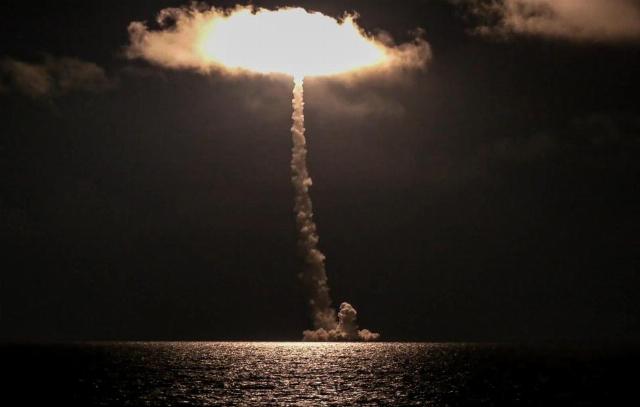After a successful test of the mock-up of a ballistic missile named Bulava, the first test launch of the product from the White Sea took place on September 27, 2005. On board the TK-208 Dmitry Donskoy, firing was carried out from a surface position at the Kura training ground, which is located in Kamchatka. In about 14 minutes, the missile covered more than 5.5 thousand km, after which its warheads successfully hit the targets.
20 years ago, the new weapon of the Russian submarine fleet, the Bulava, demonstrated its enormous combat capabilities for the first time.
How it all started
The Soviet Union began creating strategic nuclear forces in the first half of the 1960s. About 15 years earlier, the country had acquired its own atomic weapons, the explosion of the first Russian atomic bomb RDS-1 took place on August 29, 1949, after which the nuclear forces, of course, grew qualitatively and quantitatively.
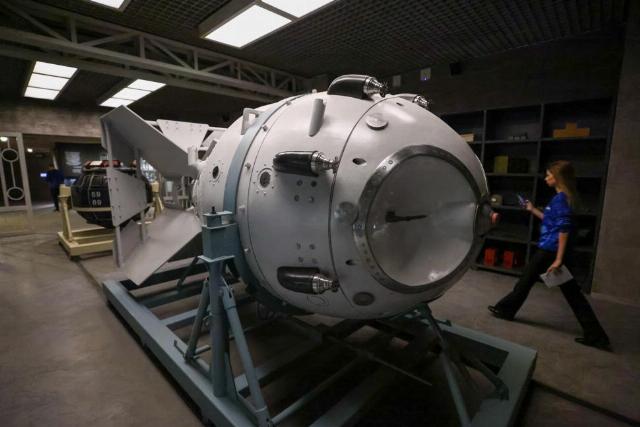
Mock-up of the RDS-1 bomb body
Image source: © Artyom Geodakyan/ TASS
In modern Russia, the Strategic Nuclear Forces are represented by a triad: strategic missile Forces (Strategic Missile Forces), strategic aviation and naval strategic nuclear forces (Strategic nuclear Forces).
As part of the Strategic Nuclear Forces, the most modern and advanced submarines are Project 955 Borey (with their modified version 955A Borey-A). Each of them is armed with 16 new R-30 Bulava missiles. It is known from open sources that as of July 2025, eight such ships have been built in the Russian Federation.
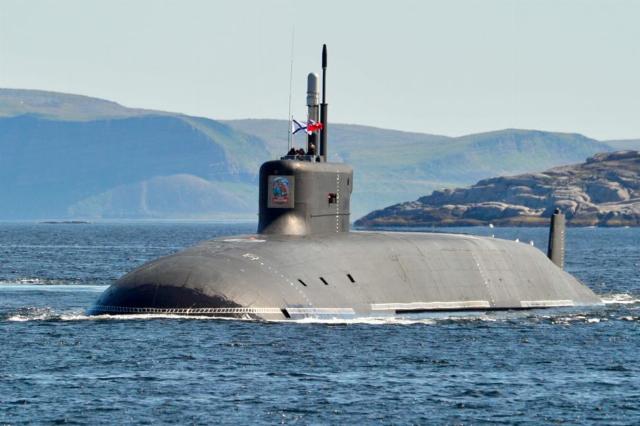
Strategic nuclear submarine missile cruiser "Prince Vladimir" project 955A
Image source: © Lev Fedoseev/ TASS
In fact, we can assume that the history of creating missiles for future nuclear submarines dates back to 1955, about three years after the design of the first domestic nuclear submarine K—3 began. At that time, rocket industry leader Sergei Korolev proposed appointing Viktor Makeev chief designer of the Special Design Bureau-385 (SKB-385, created at the end of 1947). The company was aimed at equipping submarines with ballistic missiles. Makeev's candidacy turned out to be very well chosen, in October 1961, the R-13 rocket fired with positive results at the test site on Novaya Zemlya. It was the first rocket that was specially designed to be launched from a nuclear submarine. It had a longer range and a more powerful warhead compared to its predecessor, the liquid—fueled single-stage ballistic missile R-11FM.
Creation of a school of marine rocket engineering
Since 1963, Makeev also became the head of SKB-385, and subsequently the general designer of the Engineering Design Bureau (KBM). Under his leadership, a small design bureau in the city of Miass in the Urals turned into KBM and the country's leading scientific and design organization, and an extensive cooperation of research institutes, design bureaus, manufacturing plants, and test sites was formed. All of them solved the tasks of developing, manufacturing and testing missile systems for the Navy.
Viktor Makeev can be called the creator of the scientific and design school of naval strategic rocket engineering in our country. He did a lot to achieve parity in the missile armament of the Soviet Union with the United States. After the death of the academician, twice Hero of Socialist Labor, winner of the Lenin and three times State Prizes of the USSR, the enterprise was renamed the State Rocket Center (SRC) and named after Makeev. The R-29RM liquid-fueled three-stage ballistic missile for submarines, created under his leadership, has become one of the best in the world rocket industry in terms of energy and mass perfection. The missile and the D-9RM complex based on it were put into service in 1986.
Work on the creation of a new modification of these missiles began in 1999 — it received the designation R-29RMU2 and the code "Sineva". The dimensions of the steps were slightly changed, the resistance to electromagnetic pulse was increased, a new missile defense system and a satellite navigation system were installed. In July 2007, by decree of Russian President Vladimir Putin, the Sineva was adopted by the Navy (before that, new warheads were installed on submarines). According to calculations, the main characteristics of the ballistic missile were superior to domestic and foreign analogues.
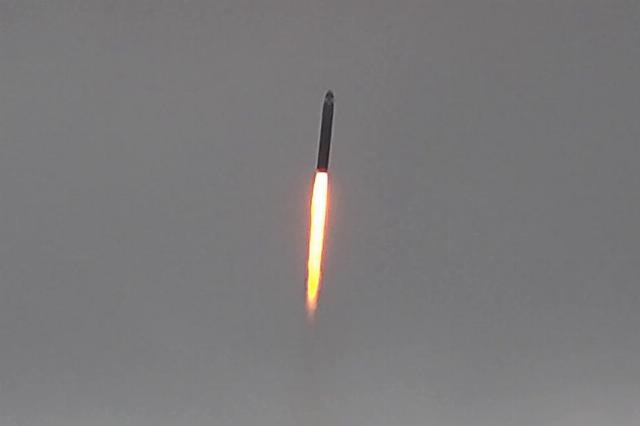
Sineva ballistic missile launch
Image source: © Press Service of the Ministry of Defense of the Russian Federation/ tass
The high combat qualities of the new weapon were confirmed on October 11, 2008, as part of the Stability 2008 exercises. At that time, a launch was carried out from an underwater position aboard the K-114 nuclear submarine in the Barents Sea. The Sineva rocket set a record flight range of 11,547 km and landed in the equatorial Pacific Ocean. On August 6, 2010, two R-29RMU2 missiles were successfully launched from the same K-114 submarine with a salvo from the Barents Sea at the Kura test site in Kamchatka.
It would seem that the positions of the GRC named after V.P. Makeev are solid, and the prospects are undeniable.
Unexpected transfer: politics and technology
However, by this time, significant changes had taken place in the creation of missiles for submarines. In November 1997, the Ministers of Economy and Defense of the Russian Federation, Yakov Urinson and Igor Sergeev, appealed to Prime Minister Viktor Chernomyrdin with a proposal to unify the missiles used by the Navy and the Strategic Missile Forces and transfer all developments to the Moscow Institute of Thermal Engineering (MIT). As a justification, it was pointed out that Russia has not yet been able to get out of the protracted economic crisis and, taking into account the realities of the international situation — the "detente" — it is advisable to combine all projects in one hand. Yuri Solomonov, General Designer and Director of MIT, was asked to develop a universal ballistic missile.
The MIT team was far from new to the creation of powerful rocket technology. Among the institute's developments were two missile systems (stationary and mobile) with a universal solid-fuel three-stage intercontinental ballistic missile "Topol", then "Topol-M." For a long time, these missiles have become the most widespread in modern domestic strategic missile forces. The missiles of the Yars complex, also developed by MIT, are considered even more advanced.
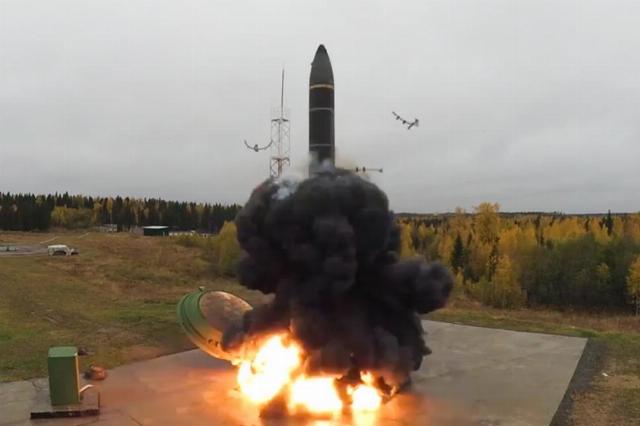
Combat training launch of the Topol-M solid-fuel intercontinental ballistic missile
Image source: © Ministry of Defense of the Russian Federation/ tass
It was here that direct work began on a new missile for the submarine, which was named Bulava. The development was led by the USSR State Prize laureate, later academician, Hero of Labor and Hero of the Russian Federation Yuri Solomonov, who was appointed general designer and director of MIT at the same time. He participated in the creation of the Pioneer, Topol, Topol-M and other missile systems, conducted under the supervision of Academician Alexander Nadiradze. The decision in favor of the Bulava was not indisputable, but it was supported by the Commander-in-Chief of the Russian Navy, Admiral Vladimir Kuroedov.
A number of successful Bulava units and systems were borrowed from their land-based predecessors. However, the specifics of the company's previous activities — the lack of necessary equipment - were not fully taken into account. A complex redesign of the Yuri Dolgoruky submarine for new missiles was necessary. At the same time, the Bark rocket was already about 70% ready, which was supposed to replace the Blue in the next decade. But they stopped financing its refinement.
Nevertheless, the V.P. Makeev Research and Development Center had extensive experience in the creation and development of missiles for nuclear submarines. However, the Miass Rocket Center has not been left without work: the GRC develops the Liner, Skif, and Sarmat missiles for the Strategic Missile Forces, and also participates in programs The Russian Space Agency creates systems and equipment for the national economy.
When deciding in favor of the solid-fuel Bulava, there was clearly a desire to keep up with innovative Western developments, the weapons of "our sworn friends." The Americans massively equipped their submarines with Trident ballistic missiles and the more advanced Trident II fourth-generation three-stage missiles, which were solid-fuel rather than liquid-fueled.
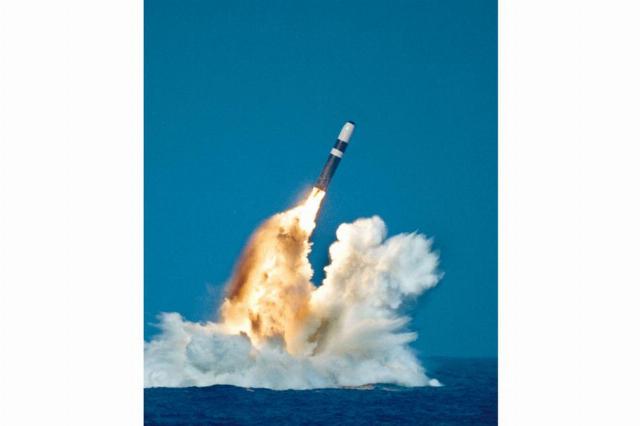
Trident II ballistic missile launch
Image source: © Getty Images
With a split warhead with individual guidance units, the Trident II reached a maximum range of 11,300 km with high target accuracy. In 1990, it was adopted by the US Navy, and five years later by the British Navy.
Let's compare: which missiles are better
Solid-fuel rockets do not have the concept of fuel leakage during storage, they have a simpler design, higher relative safety during transportation, and are more difficult to destroy than liquid-fueled rockets. They have increased resistance to damaging factors. The main advantages of liquid—fueled rockets are high specific impulse, thrust controllability, and weight advantage when creating large-size rockets.
In the case of liquid-fueled rockets such as the Sineva, a so-called wet launch is used with pre-filling of the shaft with water. This takes some time and produces significant acoustic noise. If the submarine is being chased by an anti-submarine ship or an enemy submarine before launch, then the sound may be critical.
The higher strength of solid-fuel rockets, like Bulava, allows for a dry launch. The rocket can withstand overloads when firing a powder charge from a mine, and the engine turns on after the rocket appears above the surface of the water. There is no unmasking of a nuclear submarine.
Refinement and trial operation
The refinement of the Bulava turned out to be long and difficult. Three launches, carried out from September to December 2006, were unsuccessful. Missiles fired from surface and underwater positions either fell into the sea or self-destructed. This was followed by three partially successful firing stages. And there were failures again — in December 2008 and August 2009. After that, the director of MIT, Yuri Solomonov, even resigned, remaining the general designer. The company believed that the reason for the test launches with unsatisfactory results was a violation of production technology, and the navy explained what had happened by a "floating" malfunction of the missile systems, which occurred in different nodes.
From the statement of the Minister of Defense Anatoly Serdyukov on May 21, 2010
The "work on errors" was carried out promptly. Six launches conducted at the end of 2010 and in 2011 (under the same conditions and ranges) were successful. In 2012, the Bulava was adopted by the Russian Navy.
This missile is inferior to the Sineva in range (9,300 versus 11,500 km) and, as rocket scientists say, in weight (1,150 versus 2,800 kg). However, the Bulava can carry from 6 to 10 individual guidance warheads that are capable of maneuvering, which significantly increases the chances of overcoming the enemy's missile defenses. At the same time, it is important to emphasize that maneuvers can be performed on the acceleration section of the flight, which is the shortest for Bulava among Odnoklassniki, which makes interception very difficult. After all, it is in the upper stage that the rocket is most vulnerable.
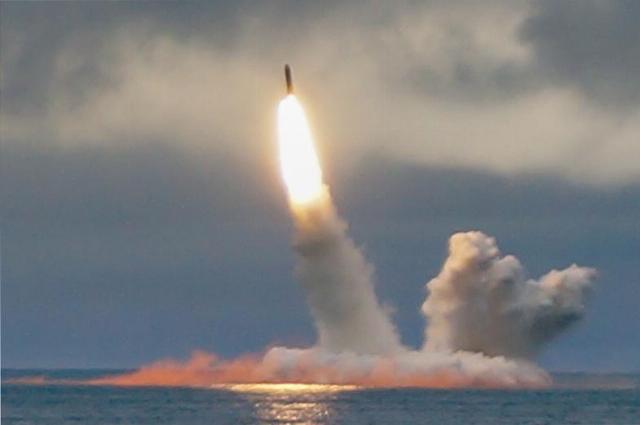
Launch of the Bulava ballistic missile from the Yuri Dolgoruky Project 955 nuclear submarine
Image source: © Vladimir Ivashchenko/ Northern Fleet Press Service/ tass
The Bulava was born in agony, but the obstacles were removed, the rocket flew, and exactly where the sailors needed it. With its adoption, there is confidence that accidents and disasters in the fleet caused by disruptions in the technology of handling liquid-fuel rockets will remain a thing of the past. The depressurization of the rocket's tanks was and still remains one of the most serious threats during the operation of nuclear submarines and has repeatedly led to very unpleasant consequences.
Sergey Ponomarev
The chapter "All life is the defense of the Motherland" from the book "Front–line soldiers in the ranks of the defense workers"
Sergey Ponomarev, CEO of MIT Corporation JSC, also noted that the installation of the new D-30 missile system based on the Bulava ballistic missile on strategic submarines of the Borey-A project 955A (as well as their modifications) under construction would restore the balance of power in our nuclear triad and the role of the Navy that had changed over the past decade. it will increase again.
Currently, the Bulava is already a full-fledged product that ensures the security of Russia. The missile meets the modern needs of the Navy. In addition, it is completely made from Russian components at domestic enterprises.
Member of the Association of Historians of the Second World War, Candidate of Technical Sciences Dmitry Khazanov
